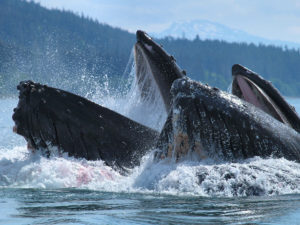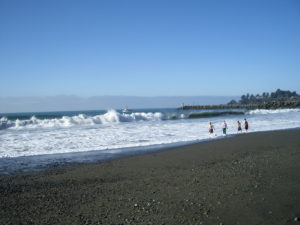Ocean Life Behavior Adaptations are the focus of this episode of Ramping Up your English.


The behavior adaptations of the animals that call the ocean their home are the behaviors that help them survive and thrive in their expansive and highly diverse environment. Previously, we learned about physical adaptations on ocean animals (See Episodes 64 and 65). Now we look at what orcas, humpback whales, and sea otters do to give them an advantage for living in today’s oceans.
For viewers who are writing a report on their chosen animal, recognizing and reporting on an animal’s behavior adaptations should be easier after viewing this episode. For those who just want to know more about animals that live in the ocean – or who just want to see awesome footage of ocean animals – this episode has a lot to offer.
Viewing Episode 66
You can watch this entire episode without ads by clicking here. That takes you to archive.org. You’re also free to download this Creative Commons program from the website.
Viewing by Segment
You can also view this episode in shorter segments.
Click here to see Segment One.
Language Objectives
Use present-tense verbs to describe on-going actions. Use sequencing words to describe a natural process. Name ocean animals after seeing them described in a video.
Academic Content Objectives
Give examples of animal behaviors that reflect an adaptation. Explain how cooperative behavior by orcas gives them an advantage in getting food. Explain how cooperative behavior by humpback whales gives them an advantage in getting food. Explain how grooming behavior by Sea Otters allows them to survive and thrive in a cold-ocean environment. List some environmental challenges faced by Marine Mammals.
Episode 66 Summary
We go back to the ocean in this episode, learning about animal adaptations. However, in this episode we’re looking at behavior adaptations. We begin with seals and sea lions – marine mammals having physical adaptations we studies earlier. This time we look at how they use some of those physical adaptations – the behavior of these animals to help them survive and thrive in the ocean environment in which they live.
Then we look at orcas (commonly known as killer whales – but they’re not whales). We consider how they gain an advantage over their prey using cooperative behavior in their hunting practices. We also learn how humpback whales (these are true whales) work cooperatively to confuse and corral their tiny prey to maximize their food intake.
Whale watching was the focus of one video clip, with some stunning video of killer whales and humpback and fin whales. Elementary school children shared what they have learned about whales during a unit for English Language Learners. A short video about the behavior adaptations of sea otters further reinforced the knowledge of behavior adaptations.
Videos used in Episode 66
To watch the video about Whale Watching, click here
For ad-free viewing on archive.org, click here.
See the video Kids and Whales.
Watch the same video ad-free on archive.org. Click here.
Watch Marine Animals
Marine Animals is also available on archive.org. Click here to see it there.
Link to outside video
Watch orcas hunt cooperatively to prey on a crab eater seal. WARNING! The orcas succeed in their hunt. Click here to see this YouTube Video.
See the world’s largest mammal – the Blue Whale. Click here.
Homework
Find behavior adaptation of the animal you’re researching. You may find this info under Behaviors, Food or Diet, Enemies or Threats or Predators. You may also find it under Anatomy – how your animal uses a physical adaptation. An example would be the flat tail of a beaver. It slaps that tail in the water to warn of danger. That’s a behavior adaptation. Take notes of these behavior, noting only the facts. We’ll teach the words and phrases needed to communicate this information in future episodes.
Next Episode
Continue learning about behavior adaptation in Episode 67. Click here to visit the Episode 67 page.
